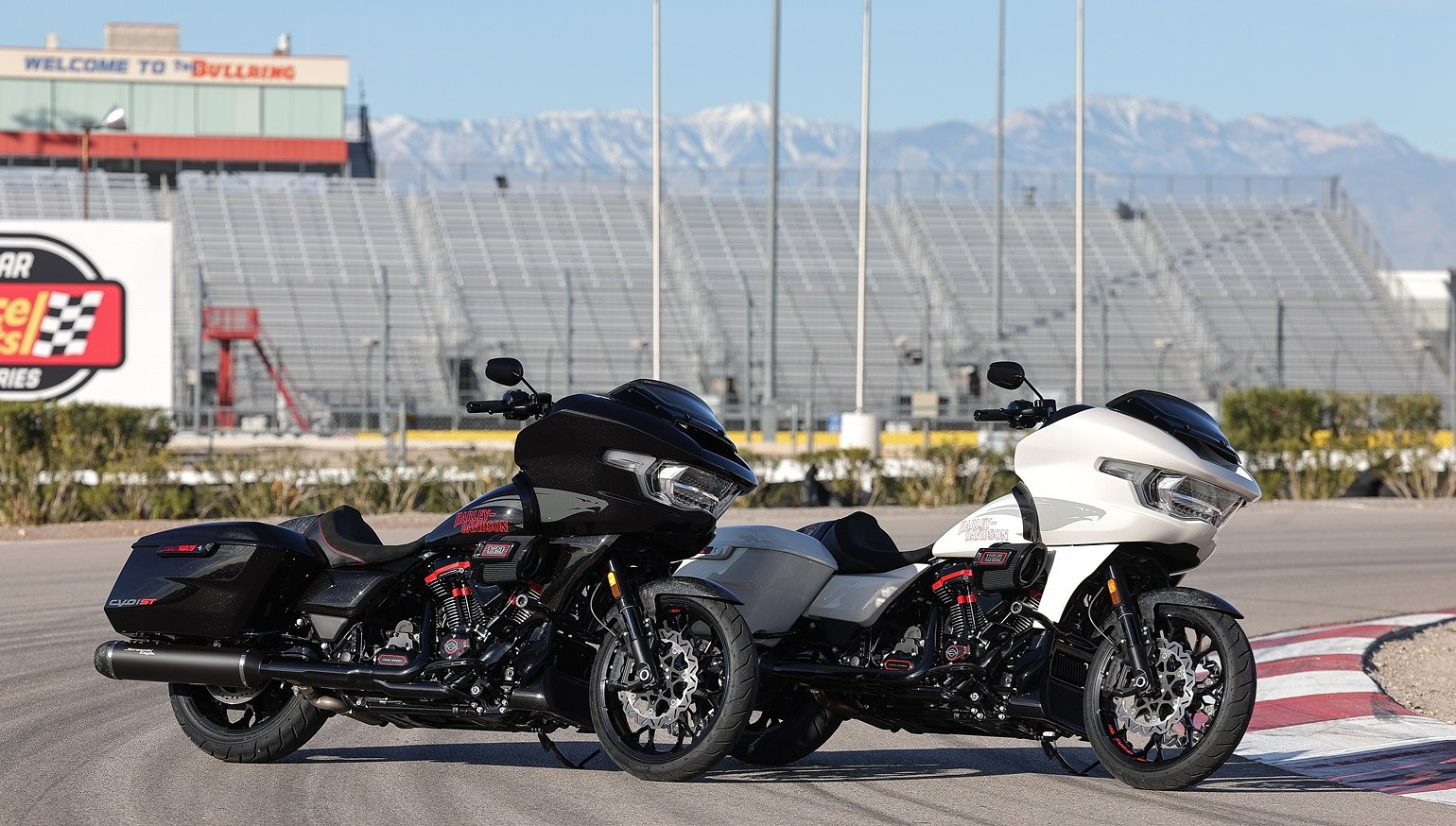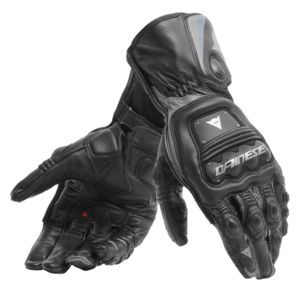As Harley-Davidson engineers and designers worked on the 2024 CVO Road Glide ST in recent years, there was a constant push and pull between two directions. How much King of the Baggers and how much real-world bagger? How much hot performance and how much cool comfort? And even what color to paint it?
In the end, the company played it down the middle. On one hand, you have two separate Track modes with a throttle map that's "literally a copy paste," as Kyle Wyman put it, from the throttle-response map used on Wyman's MotoAmerica Mission King of the Baggers race bike. On the other hand, you still have a Rockford Fosgate Stage II audio system with a 500-watt amplifier. Best of both worlds? Or multiple personality disorder?
I got a chance to ride the new ST for some laps around the road course outside Las Vegas Motor Speedway to find out. While I wasn't able to come anywhere close to exploring the ST's full performance capabilities, and even less close to exploring all the ST's technological features in the short time available, I did begin to form some answers.
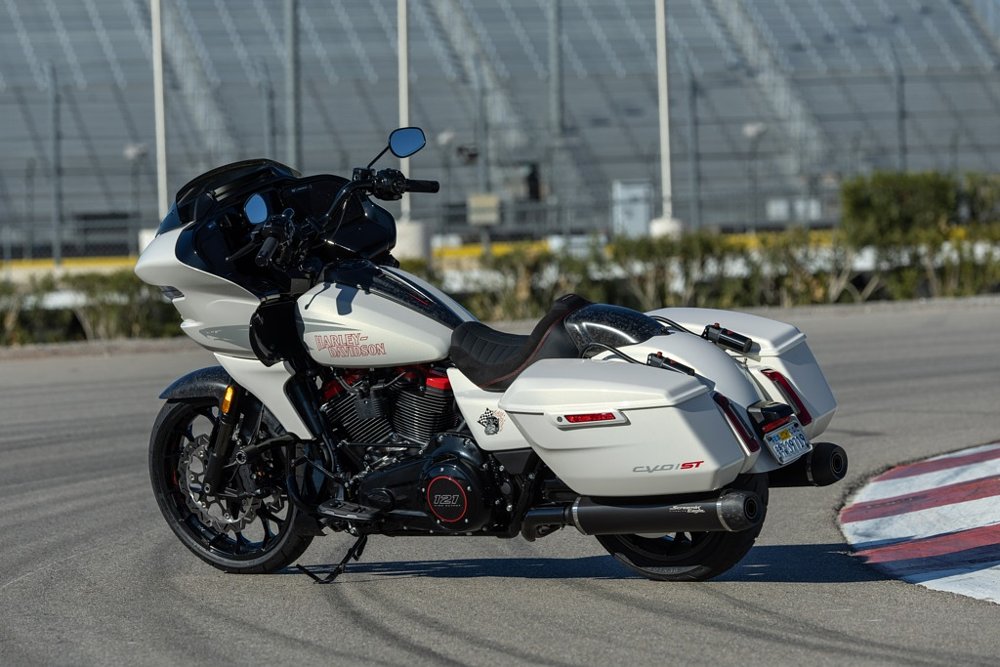
Performance and bagger
While I hit the highlights of the new CVO Road Glide ST in my previous story on new Harley-Davidson models for 2024, there's a lot to unpack. A look at most of Harley-Davidson's limited-edition CVO models starts with appearance — including the most high-quality production-line paint jobs you'll likely see anywhere — and a thick layer of premium features, with performance tweaks coming third. In this case, I have to start by talking about the Milwaukee-Eight 121 High Output engine.
Variable valve timing allows a broader spread of power, so you can have both low-end torque and good top-end power. You don't see variable valve timing in a race engine because it's all about maximum horsepower, not a broad spread. The ST's 121 engine loses the variable valve timing from the 121 VVT in exchange for peak output. "You're going to feel like this is a race tune," said H-D Vice President of Design Brad Richards.
The 121 HO engine redlines at 5,900 rpm, compared to the 5,600 rpm of the 121 VVT. To take full advantage, engineers paid a lot of attention to the air intake. They said the new design flows 26% more air than the 121 VVT and a smoother intake manifold improves airflow. Harley-Davidson claims the result is 127 horsepower at 4,900 rpm and 145 foot-pounds of torque, the highest torque figure of any Harley-Davidson production engine. The Milwaukee-Eight HO still has liquid-cooled heads and air-cooled cylinders, with the radiator painted black and tucked discretely and low behind the front wheel. To maximize cooling efficiency, engineers reworked the system to send cooling water to the rear cylinder first, since it gets hotter.
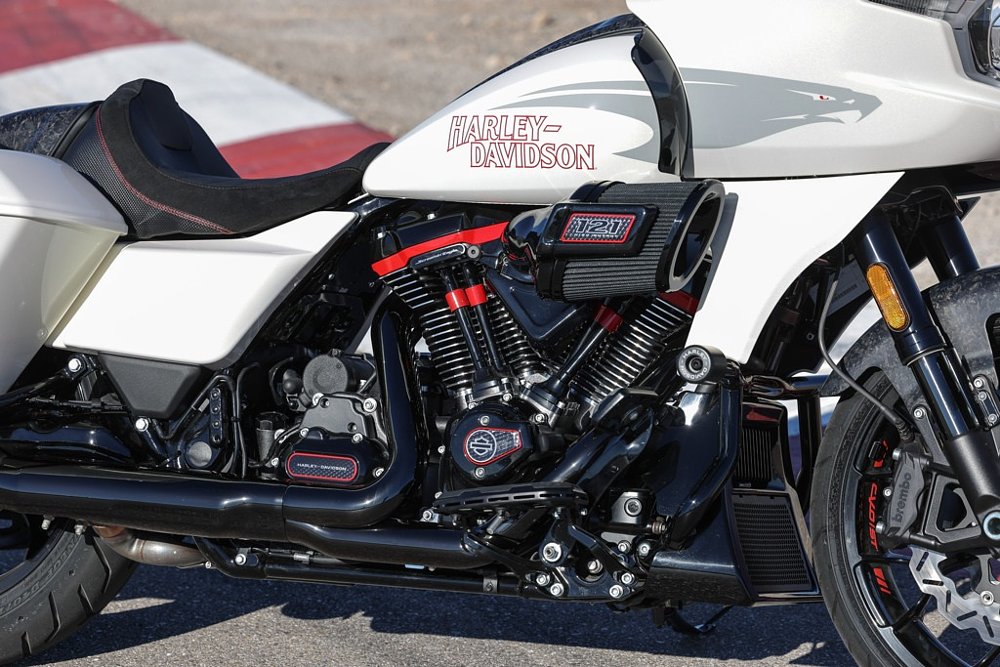
Most companies don't talk about weight reduction when they're showing off a motorcycle that weighs more than 800 pounds, but baggers aren't petite. Harley-Davidson trimmed weight through a variety of changes, from the forged carbon fiber pieces (which also add a unique look) for the seat cowl and front fender, titanium shells in the mufflers, an oil pan made of lightweight composite, and even thinner metal in the fuel tank. It only adds up to a six-pound reduction from the 2023 (non-CVO) Road Glide ST, but it's a whopping 60 pounds lighter than the 2022 CVO Road Glide, since CVO models often have extra equipment.
Showa suspension is fully adjustable, front and rear, and Brembo four-piston calipers and wave-style rotors provide sophisticated stopping apparatus. Front and rear brakes are electronically linked, depending on the ride mode, which I'll explain later.
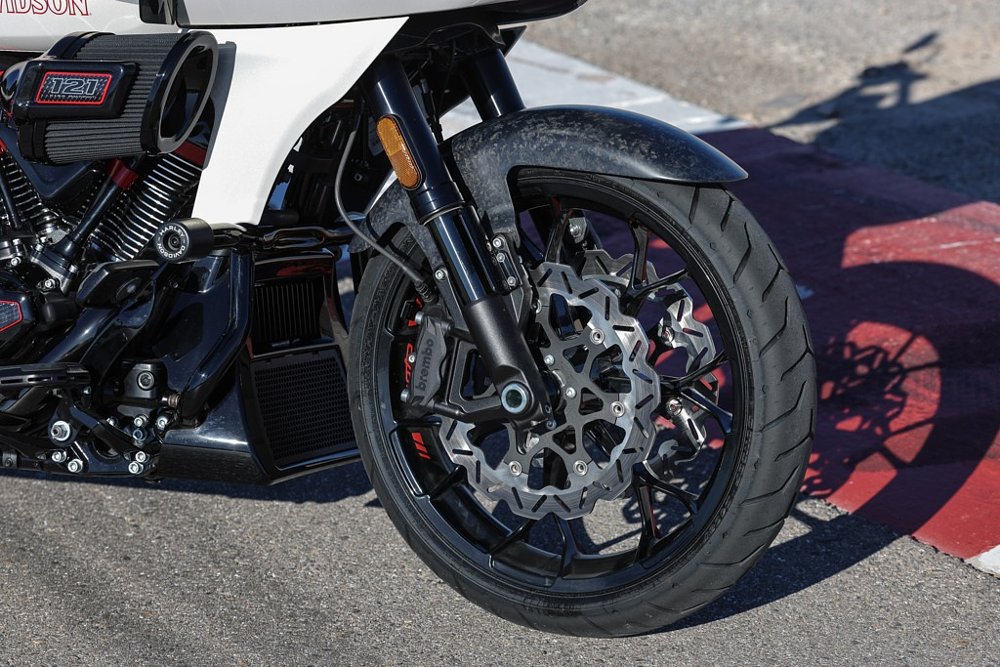
"We've been wanting to create an ST version in our CVO line for a long time," Richards said. He noted that this model was developed entirely after Harley-Davidson began participating in the King of the Baggers series, and the company is all-in now, not only running its factory team but also working with the front-running Vance & Hines and Saddlemen teams. Harley-Davidson's racing involvement dates back more than a century to hillclimbs and board-track races, carried on with dominance in Grand National flat-track racing, and has taken to roadracing tracks in spec series featuring 883 Sportsters and XR1200s. There was even a CVO V-Rod Destroyer drag-race bike. But performance baggers are something different.
"Harley-Davidson has been in racing since the beginning," said Kyle Wyman, "but you could argue that they've never raced anything this close to their best-selling product."
So that makes the CVO Road Glide ST a product with no road map. How much race and how much bagger? Consider, even, the choice of paint. While the Golden White Pearl and Raven Metallic paint are typical unique and high-quality CVO treatments, black and white are not the most natural choices for conjuring a reference to the race team. There's a fairly discrete "Fast Johnnie" logo on the side that hearkens back to Harley's board-track racing days and the STs get the Screamin' Eagle logo on the side, but not a blatant orange-and-black take on the race livery.
It's all about taking that middle approach, between racing bagger and traditional bagger. So how does it work?
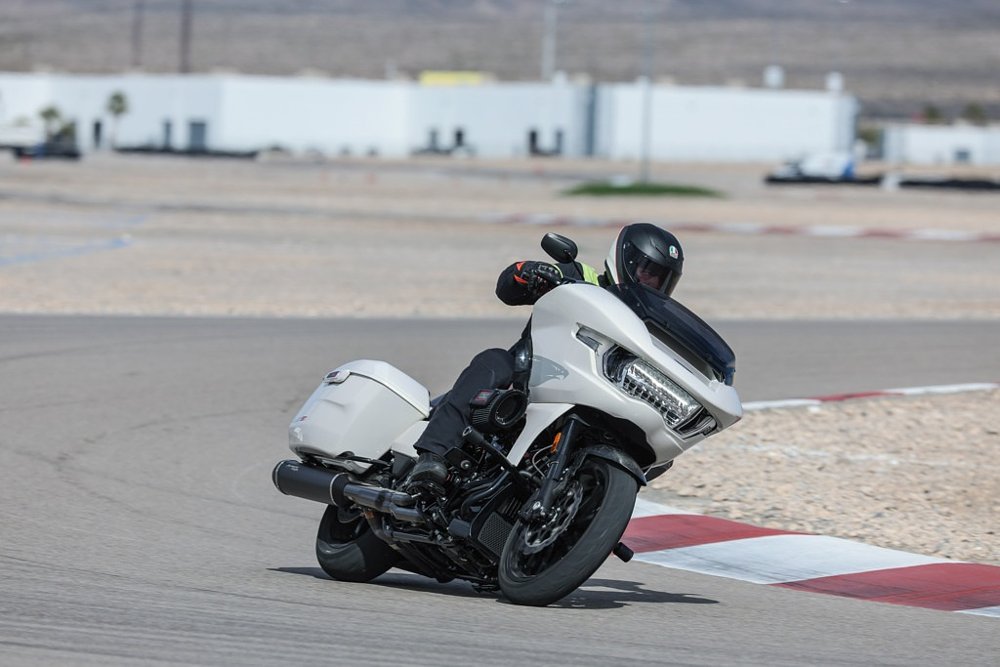
Riding the 2024 Harley-Davidson CVO Road Glide ST
Perhaps mindful of what could happen if they turned loose a pack of motorcycle writers and YouTubers unsupervised on the track on $43,000 baggers, Harley-Davidson limited us to cutting laps behind the lead of James Rispoli, the new member of the Harley-Davidson Screamin' Eagle factory racing team, and Travis Wyman, who will be riding for the Saddlemen team in KOTB this year. To give us a taste of real-world conditions — or maybe just to slow us down on the back straight — they also set up cones on the track and we had to do two tight U-turns. As a result, I didn't spend any meaningful time above third gear and never saw an indicated speed higher than 88 mph (I'm told top speed is a governed 120 mph). We were on the track, but the experience more resembled a spirited street ride.
Given the setting and the limited time, I didn't even attempt to explore the rich set of features accessed through the ST's huge touch screen display. No syncing with my phone to take calls, no tuning in the local radio station for some mariachi music, no testing the embedded navigation enabled by the bike's onboard Wi-Fi. No time for that. Instead, I focused on the ST's performance.
The first and very welcome impression was my surprise at how easy it was to tip an 838-pound bagger into the tight corners of the LVMS outside road course. I wouldn't have thought it possible to transition from side to side on a motorcycle of that size with that little rider input.
The ST comes with Road, Sport, Rain, Track, and Track Plus modes, and the rider can also create four custom modes by selecting combinations of different levels of torque delivery, engine braking, throttle response, cornering traction control intervention, and cornering anti-lock braking intervention. In the first session, with the ST set to Sport mode, the bike would leap off the line at the crack of the throttle. I can safely say I haven't ridden a motorcycle of this type that was faster.
It was after that first session that Kyle Wyman told us that the Track mode used his preferred throttle response, which actually has a softer hit at smaller throttle openings. It may seem counterintuitive until you think about it, but it makes perfect sense. When you're transitioning from full lean to upright and eager to get on the gas, you don't want a sudden hit of power. During my second session, with the ST in Track mode, it felt easier for me to stay smooth.
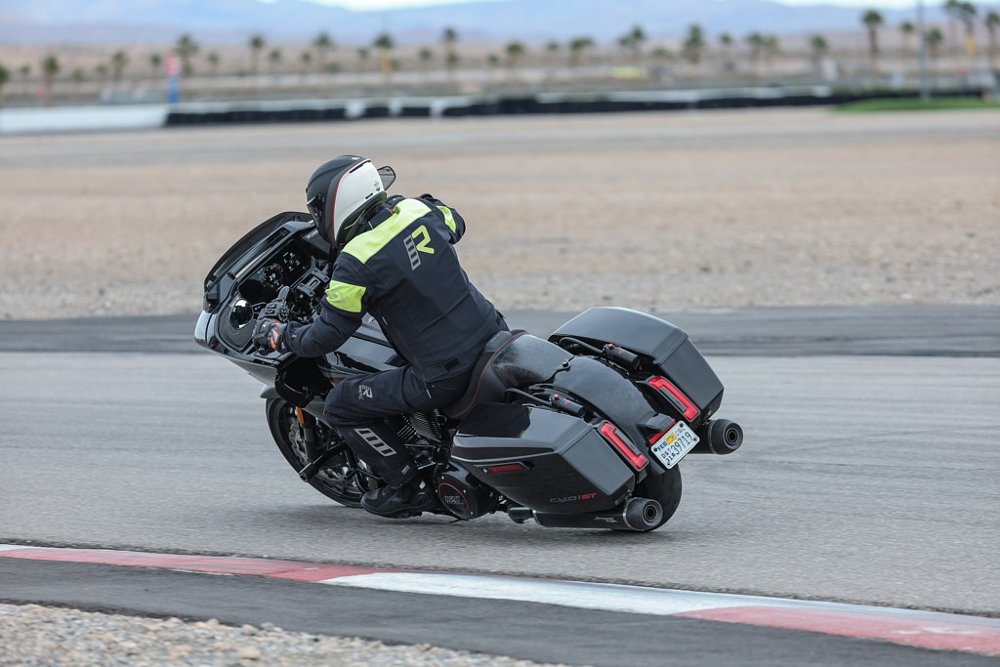
In the three road-going modes, the front and rear brakes are electronically linked. This can be handy for any kind of rider, whether you're coming from a sportier motorcycle with a shorter wheelbase and you're used to relying heavily on the front brake, or you're coming from a cruiser with a lower performance threshold and you're used to relying more on the rear brake. Using either the pedal or lever gets you combined braking. Track mode, however, disables the rear-to-front linkage so the rider can use the rear brake independently. It also reduces the level of ABS and traction control intervention. Track Plus mode disables the linked braking entirely and reduces ABS and traction control further. (Separately from the modes, traction control can be turned off entirely. ABS cannot be fully disabled.)
In my third session, I switched to Track Plus mode, but since we weren't riding hard enough to trigger traction control, it felt the same as Track mode. In the fourth session, I tried Road mode and I didn't feel like I was lacking anything. Road provides a less aggressive throttle response than Sport and supposedly provides a little less mid-range power, but it wasn't noticeable. I suspect if I were riding the CVO ST long term, I'd spend just about all of my time on the street in Road mode and switch to Track for a track day. Sport mode seems perfectly suited to making you feel like a hero by blasting away from traffic when the stop light turns green.
Maybe one reason I didn't notice any mid-range difference in Road mode was because with the 121 HO engine it's easy to stay in the upper end of the rev range. It's still a big V-twin, but it revs quickly enough and stays smooth to redline, so there's no harshness encouraging me to shift early. On the contrary, I banged into the rev limiter far more times than any competent rider would want to admit to, just because I was busy trying to watch Rispoli's lines and not the tachometer and the engine wasn't sending me aural or tactile messages of distress.
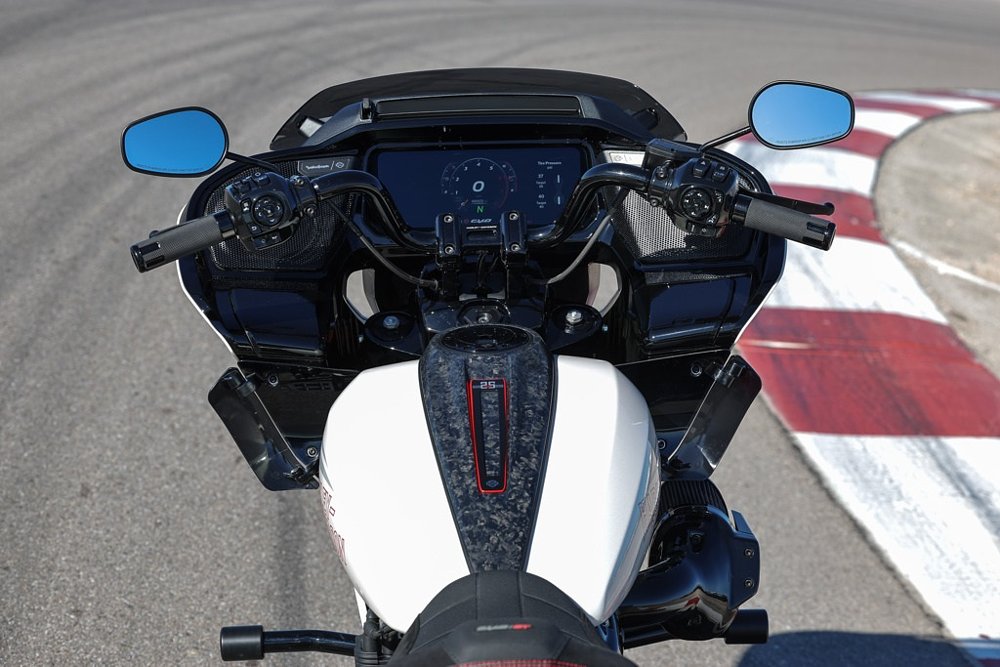
There are a few drawbacks for performance riding on the track that may or may not bother some riders on the street, and they're direct results of following that middle path between race and bagger. For me, the biggest impediment to riding the ST at a respectable pace on the track was the traditional position of the gear shift lever. One of the decisions the design team debated was footpegs or floorboards. In the end, they took the middle way and went with floorboards that are smaller than other non-CVO baggers. They are placed moderately forward, so they're not optimal for shifting your weight. But more importantly, there's no such thing as snicking up through the gears with a flick of a toe. I had to move my foot and raise my entire lower leg to shift gears, and as a result I missed a few shifts and unintentionally found neutral a couple of times. The same issues would apply to the brake pedal, but I avoided that by relying on the linked brakes. Your feelings on the setup may depend on what you're used to and how hard you ride, but I would have liked to have seen footpegs and a snickable gear shift lever on Harley-Davidson's most high-performance bagger ever.
It's not a big deal — and again, it will depend a lot on your personal preference and what you're used to — but the handlebar rise is also quite high for track riding. My final nitpick is the clutch lever action, which is unsurprisingly heavy. I wouldn't criticize the smoothness of the clutch pull on a lesser bike but we're talking about a $43,000 motorcycle and touchpoints like levers are among the elements that add to or detract from the feel of quality and sophistication. At what price point do we maybe get a hydraulic unit or at least a smoother cable?
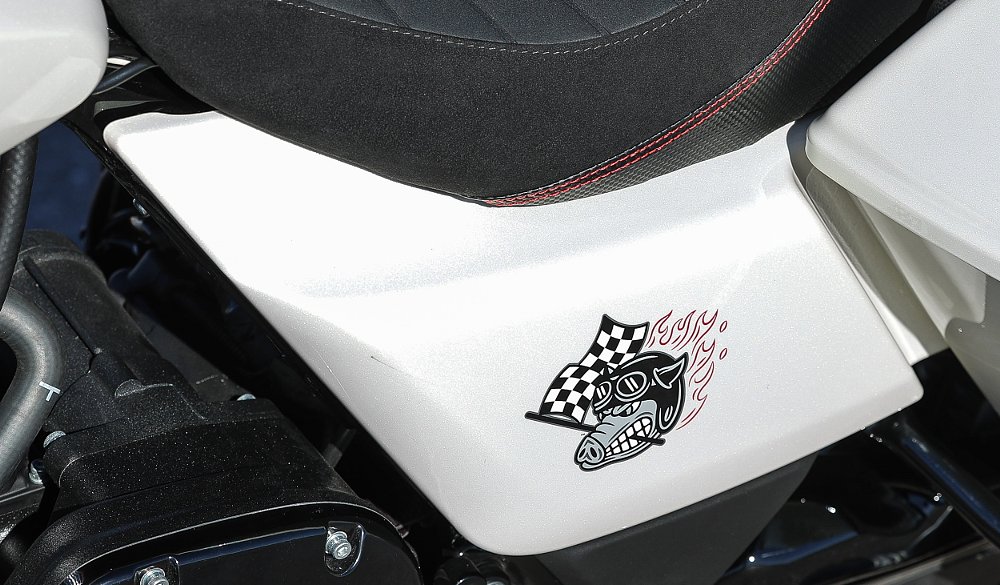
Despite having more than 800 pounds to whoa down, the Brembo brakes never felt stressed and were up to the task of the pace we were riding. The Harley team had set up the suspension for a rider of about my weight, once gear is added, and I never felt any need to make adjustments. I can't say how the Showa suspension will work on rougher real-world roads. After all, even though it's an improvement over past practice, the ST still only has three inches of rear suspension travel. But the bike felt solid, stable, and planted on the track.
I thought that riding the heaviest motorcycle I've ridden in a few years and the most powerful bagger Harley-Davidson has ever built might be a handful for me on the track. But the CVO Road Glide ST's smooth power delivery, solid brakes, and stable suspension made it a no-sweat ride. I'm sure I could still find a way to get it all sideways if I upped the pace, but I don't have near enough of a rebellious streak to pass James Rispoli and go rogue. And I'm happy to add that after four sessions of doing those damn U-turns on a Road Glide with a 64-inch wheelbase, I've now gone from being one of the worst U-turners in the world to merely being very bad at it.
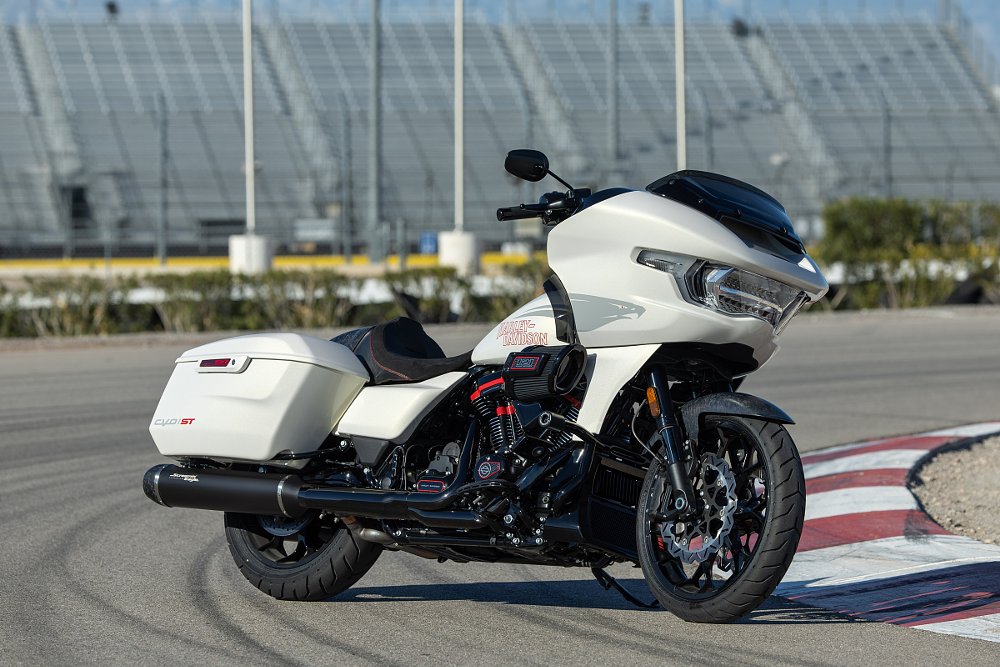
So who's going to buy a CVO Road Glide ST?
Harley-Davidson's CVO models are built for a specific kind of customer. You already knew, before you started reading this review, whether there was even the slightest chance you'd ever buy one.
I'd refer to a motorcycle like the 2024 Harley-Davidson CVO Road Glide ST as a "bragging rights bike." If you have that kind of cash and the desire to stake the claim to owning the gnarliest production bagger Harley-Davidson has yet built, then this is aimed at you. Harley-Davidson no longer reports the number of CVO models it produces and sells, but that number is limited, so if you buy one, you can be quite confident another bike just like yours isn't going to pull up beside you at Bike Night.
Harley-Davidson's designers know that some people will say they should have left off the amp and speakers and saved 20 pounds. They know others will have no idea why anyone would ever want to rev to redline. But they took the middle road, and if you're financially flush and find yourself in the middle, wanting both performance and bagger, you're their target.
| 2024 CVO Road Glide ST | |
|---|---|
| Price (MSRP) | $42,999 |
| Engine | Milwaukee-Eight High Output 121 1,977 cc, air-and-liquid-cooled, eight-valve, V-twin |
|
Transmission, final drive |
Six-speed, belt |
| Claimed horsepower | 127 @ 4,900 rpm |
| Claimed torque | 145 foot-pounds |
| Frame | Steel tubular |
| Front suspension | Showa 47 mm inverted fork with adjustable preload, compression, and rebound damping; 4.6 inches of travel |
| Rear suspension | Showa shock adjustable for preload, compression, and rebound damping; 3.0 inches of travel |
| Front brake | Brembo dual radial-mount four-piston calipers, 320 mm discs, with ABS |
| Rear brake | Brembo single-piston caliper, 300 mm disc, with ABS |
| Rake, trail | 26 degrees, 6.7 inches |
| Wheelbase | 64 inches |
| Seat height | 28.3 inches |
| Fuel capacity | 6.0 gallons |
| Tires | Dunlop D408F 130/60B19 front, Dunlop 407T 180/55B18 rear |
| Claimed weight | 838 pounds wet |
| Available | Now |
| Warranty | 24 months |
| More info | harley-davidson.com |




